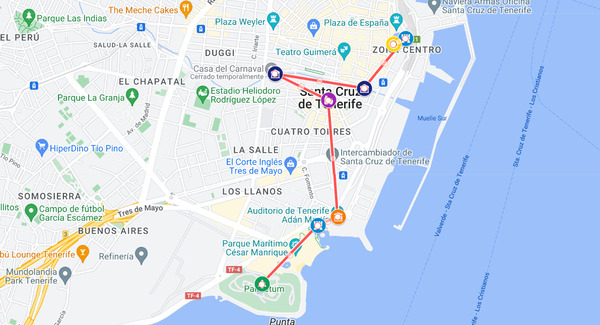Discover Tenerife

Map of the most relevant sites in the city of Santa Cruz de Tenerife. It is made to be visited in a single day. Very interesting places are left out of this route but more time would be needed to enjoy them.
If you want to download the itinerary so you can consult it on your mobile and not miss any place click on the button below.
Why choose Tenerife
Tenerife, the largest island of the Canary Islands, is a vibrant and diverse destination that offers a unique combination of stunning natural landscapes, rich cultural history, and a varied tourist offering that attracts millions of visitors each year. With its mild climate year-round and strategic location in the Atlantic Ocean, off the northwest coast of Africa and under Spanish sovereignty, Tenerife is a meeting point for tourists from around the world.
The island is distinguished by the majestic Teide, a volcano that is not only the highest peak in Spain at 3,718 meters, but also the heart of one of the most visited national parks in Europe. Teide National Park, a UNESCO World Heritage site, offers otherworldly landscapes with vast expanses of petrified lava and rock formations that tell the geological history of the island. Activities in the park include hiking, cable car rides to near the summit of the volcano, and stargazing, given the clarity of the skies in this area.
Besides Teide, Tenerife is famous for its exceptional coastline. The island’s beaches range from volcanic black sands in the north to gleaming golden sands in the south. Playa de las Américas and Los Cristianos are two of the most popular areas, known for their vibrant nightlife, wide range of accommodations, and calm waters. In contrast, the north coast offers more tranquil destinations like Garachico and Puerto de la Cruz, where the environment is greener and Canarian traditions more palpable.
Culturally, Tenerife is a melting pot of influences, reflected in its architecture, festivals, and cuisine. La Laguna, another UNESCO World Heritage City, is notable for its well-preserved historical center dating back to the 16th century. The city was one of the first unfortified colonies and serves as an example of the exchange of influences between Europe, America, and Africa.
Festivals and events in Tenerife capture the essence of its cultural identity, with the Santa Cruz Carnival being one of the most outstanding and colorful in Europe. For several weeks in February, the streets of Santa Cruz are filled with music, dancing, and parades, in a spectacle that attracts visitors from all over the world.
As for the cuisine, local dishes reflect the rich agricultural diversity of the island. Ingredients such as potatoes, bananas, gofio (toasted cereal flour), and a variety of fresh fish dominate the cuisine. Typical dishes include «papas arrugadas» (potatoes cooked in their skin with plenty of salt) served with «mojo picón,» a spicy sauce that is a traditional accompaniment.
